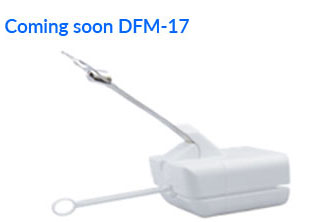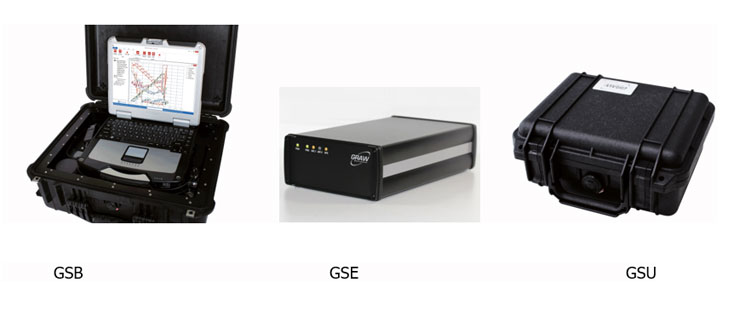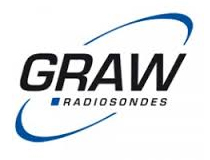GRAW is a well-established German company developing and manufacturing Upper Air Sounding Systems since 1938. GRAW’s customers are military, academic research and meteorological institutions worldwide.

Extremely Low Weight
GRAW’s latest state-of-the-art radiosondes, the DFM-09, is currently the smallest and lightest synoptic radiosondes available on the market today. The DFM-09 has dimensions of 200mmx42mmx60mm and weighs just 90 grams (Ready to Fly)! The DFM-09 has already proven itself to many customers worldwide - delivering excellent performance, ease of use, and high reliability.
Sensor Boom

Multi GNSS PTU Radiosonde (GPS, GLONASS, BEIDOU) Excellent temperature and humidity accuracy Highly stable transmitter Status indication via status LEDs Optional XDATA interface Optional barometric pressure sensor Optional ground check via Near Field Communication (NFC)
Function and Design
The DFM-09 radiosonde is designed to reliably measure the atmospheric profile of pressure, temperature, humidity, wind speed, and wind direction Continuous data sets are sent to the ground station by a high quality radio-telemetry link.
High-Power Lithium Battery
Differential C/A-Code GPS for Wind Finding
The GRAW radiosonde family has a standard on-board C/A code-correlated GPS receiver. Fully coded GPS allows the ground station to be used on the move, such as launching from a vehicle or from a ship.
High Quality Telemetry
Each sonde contains a high specification telemetry transmitter. The radio transmission from the sonde meets demanding radio requirements and can cope with long slant ranges, even as far as 300 km. The use of code-spreading, a method where link-errors can be readily detected and corrected and other modern digital radio techniques such as interleaving which minimises the effect of burst errors, ensures that the data is reliably received at the distant ground station.
The continuous on-board measurements of all sensors and transmission of their data is performed in a time-window of less than one second. Additionally, in a spare channel, diagnostic information from the sonde’s on-board Built In Test (BIT) systems are transmitted, thus ensuring the data sent is reliable during the ascent.
Freely Programmable Frequency
Each Radiosondes can transmit in a narrow channel anywhere within the meteorological band (400 to 406 MHz). The sonde uses an on-board frequency synthesiser, which is automatically set to the desired transmission channel during initialisation.
The highly-sensitive ground station receiver system does not require a steered antenna and can receive valid data from sondes up to 300 km slant range using its compact dual antenna set.
Ground station

Overview
The main function of the Ground station is receiving the Radiosondes signal and providing local GPS information. All functions are software-controlled by a standard Windows PC / Ruggedized Notebook via USB.
SDR (Software Defined Receiver)
Antenna Switch (Diversity)
GPS Module.
Software
Meteorological Messages (WMO)
Antenna System

GRAWMET Software

Switch on, plug in and go
It has never been easier and faster to initialise a radiosonde and to make it ready for take off. No redundant clicks. No time-consuming preparation. You can concentrate purely on the analysis and evaluation of the data. The sounding is detected automatically. You are automatically provided with the graphical and tabular views that are relevant for you. Following sounding there’s no need to worry about the transfer of your results. GRAWMET takes care of this for you
The system generates WMO and STANAG weather messages as well as various graphical and tabulated evaluations. The software uses the common windows style graphical user interface (GUI) making it easy to work with. Data from the radiosonde is received by the groundstation for further processing by GRAWMET.
Automatic Creation of Weather Messages

The program computes and automatically generates standardised current weather messages upon reaching the specific altitude limit. Optionally, the user can change the altitude limits. Provisional computation of weather messages before the set altitude limits are reached is also possible. For greater clarity, all messages computed are presented in the status tree.
Generated Messages (Extract)
.jpg)
These weather messages are displayed on the screen in tabulated form and can be filed for future reference. During the ascent, all data of the weather message can be viewed by scrolling. The message headings and body of the message can be later edited in order to supplement messages, if incomplete.
Weather Indices
GRAWMET creates the following weather indices automatically: LFC, LCL, CCL, Showalter Index, CAPE, CINH, EL-Equilibrium Level, K-Index, Total Index, KO Index.
Graphic Data Processing

Various parameters can be displayed and printed in the form of different graphical presentations: Thermodynamic Diagram, Tephigram, T-Log (P) Diagram, Emagram, Hodograph, Altitude Diagram, Refractive Index, etc.
Multiple Languages
The system is designed as a multiple language system. Apart from the main languages (English, German, French, Spanish), several other languages are available. Please contact us!
Google-Earth Support
The flight-path of the radiosonde can also be monitored by Google-Earth.
GRAWgo cloud-based analyses
Watch your upper air sounding stations – from anywhere at any time
GRAWgo is the latest cloud-based solution to monitor your upper air sounding stations. Access your stations from anywhere at any time. GRAWgo allows you to always keep an eye on the status of your sounding and your current sounding data of all stations. Features like the overview of current events and push notifications (start and balloon burst detection, error detection), measurement and receiver data, status of weather messages, charts, quality of data reception, flight track view, etc. make this App the perfect companion for mobile monitoring. A further and great application possibility of GRAWgo is the local status monitoring during the ascent preparation, since you get all necessary status information during preparation and during the ascent start directly on-site. The App-based application is intuitive and easy to use and it is available for iOS and Android smartphones.
Balloon Filling Unit SO-2

This unit facilitates the filling and preparation of the balloons:
The neck of the balloon is put over the nozzle of the SO-2 which is connected to a gas (helium or hydrogen) cylinder or storage tank. Weights are put on the arms of the SO-2 depending on the requested free lift. The filling of the balloon is automatically stopped once the desired free lift is reached and the balloon may then be tied to the Radiosondes. The SO-2 can be used for balloons 200 grams and larger. For smaller balloons other suitable units are available.

